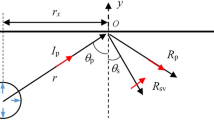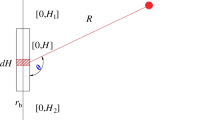Abstract
The dominant frequency, in addition to the peak particle velocity, is a critical factor for assessing adverse effects of the blasting vibration on surrounding structures; however, it has not been fully considered in blasting design. Therefore, the dominant frequency-dependent attenuation mechanism of blast-induced vibration is investigated in the present research. Starting with blasting vibration induced by a spherical charge propagating in an infinite viscoelastic medium, a modified expression of the vibration amplitude spectrum was derived to reveal the frequency dependency of attenuation. Then, ground vibration induced by more complex and more commonly used cylindrical charge that propagates in a semi-infinite viscoelastic medium was analyzed by numerical simulation. Results demonstrate that the absorptive property of the medium results in the frequency attenuation versus distance, whereas a rapid drop or fluctuation occurs during the attenuation of ground vibration. Fluctuation usually appears at moderate to far field, and the dominant frequency generally decreases to half the original value when rapid drop occurs. The decay rate discrepancy between different frequency components and the multimodal structure of vibration spectrum lead to the unsmooth frequency-dependent attenuation. The above research is verified by two field experiments. Furthermore, according to frequency-based vibration standards, frequency drop and fluctuation should be considered when evaluating blast safety. An optimized piecewise assessment is proposed for more accurate evaluation: With the frequency drop point as the breakpoint, the assessment is divided into two independent sections along the propagating path.












Similar content being viewed by others
Abbreviations
- PPV:
-
Peak particle velocity
- f :
-
Frequency
- r :
-
Distance from blast source to monitoring point
- Q :
-
Maximum charge per delay
- e :
-
Explosive specific energy
- d :
-
Borehole diameter
- ρ :
-
Rock density
- C R :
-
Surface wave velocity
- λ :
-
Lame coefficient
- μ :
-
Lame coefficient
- V P :
-
Velocity of longitudinal wave
- ν :
-
Poisson’s ratio
- r e :
-
Equivalent elastic boundary radius
- ω :
-
Angular frequency
- Q r :
-
Geology quality factor
- f d :
-
Dominant frequency
- EOS:
-
Equation of state
References
Ak H, Iphar M, Yavuz M, Konuk A (2009) Evaluation of ground vibration effect of blasting operations in a magnesite mine. Soil Dyn Earthq Eng 29(4):669–676
Aldas G (2010) Explosive charge mass and peak particle velocity (PPV)-frequency relation in mining blast. J Geophys Eng 7(3):223
Aldas G, Ecevitoglu B (2008) Waveform analysis in mitigation of blast-induced vibrations. J Appl Geophys 66(1):25–30
Barton N, Lien R, Lunde J (1974) Engineering classification of rock masses for the design of tunnel support. Rock Mech 6(4):189–236
Blair D (2008) Non-linear superposition models of blast vibration. Int J Rock Mech Min Sci 45(2):235–247
Dauetas A, Denisyuk I, Kuzmenko A, Vorobev V (1993) Seismic effects of blasting in rock, vol 103. CRC Press, New York
Dowding CH (1985) Blast vibration monitoring and control, vol 297. Prentice-Hall, Englewood Cliffs
Dowding C (1996) Construction vibrations, vol 610. Prentice Hall, Upper Saddle River, NJ
Dowding CH, Atmatzidis DK, Murray PD (1981) Dynamic properties of residential structures subjected to blasting vibrations. J Struct Div 107(7):1233–1249
Fomel S, Landa E (2014) Structural uncertainty of time-migrated seismic images. J Appl Geophys 101:27–30
Foti S, Comina C, Sambuelli L, Callerio A, Caleffi A (2010) The role of surface waves in prediction of ground vibrations from blasting. Vib Blast 57–65
Hagan T (1979) Rock breakage by explosives. Acta Astronaut 6(3–4):329–340
Khandelwal M, Singh T (2006) Prediction of blast induced ground vibrations and frequency in opencast mine: a neural network approach. J Sound Vib 289(4):711–725
Liang Q, An Y, Zhao L, Li D, Yan L (2011) Comparative study on calculation methods of blasting vibration velocity. Rock Mech Rock Eng 44(1):93–101
Lu W-B, S-x Lai, C-y Zhu, D-q Shu (2001) Safety standards of blast vibrations adopted in rock base excavation of three gorge project. Explos Shock Waves 21(1):67–71
Lu W-B, Luo Y, Chen M, D-q Shu (2012) An introduction to Chinese safety regulations for blasting vibration. Environ Earth Sci 67(7):1951–1959
Monjezi M, Ghafurikalajahi M, Bahrami A (2011) Prediction of blast-induced ground vibration using artificial neural networks. Tunn Undergr Space Technol 26(1):46–50
Ricker NH (1977) Transient waves in visco-elastic media, vol 10. Elsevier, Amsterdam
Sambuelli L (2009) Theoretical derivation of a peak particle velocity–distance law for the prediction of vibrations from blasting. Rock Mech Rock Eng 42(3):547–556
Singh P, Roy M (2010) Damage to surface structures due to blast vibration. Int J Rock Mech Min Sci 47(6):949–961
Singh A, Parween Z, Chatterjee M, Chattopadhyay A (2015) Love-type wave propagation in a pre-stressed viscoelastic medium influenced by smooth moving punch. Waves Random Complex Media 25(2):268–285
Wang I-T (2014) Numerical and experimental verification of finite element mesh convergence under explosion loading. J VibroEng 16(4):1786–1798
Wu C, Hao H (2005) Numerical study of characteristics of underground blast induced surface ground motion and their effect on above-ground structures. Part I. Ground motion characteristics. Soil Dyn Earthq Eng 25(1):27–38
Zhong GS (2006) Applied fundamental research of blasting vibration analysis based on wavelet transform [Ph.D. dissertation]. Central South University, Changsha (In Chinese)
Zhong G, Ao L, Zhao K (2009) Influence of explosion parameters on energy distribution of blasting vibration signal based on wavelet packet energy spectrum. Explos Shock Waves 29(3):300–305
Acknowledgments
This work is supported by Chinese National Science Fund for Distinguished Young Scholars (51125037), Chinese National Programs for Fundamental Research and Development (973 Program) (2011CB013501), Chinese National Natural Science Foundation (51279146 and 51179138) and the Fundamental Research Funds for the Central Universities (2012206020205). They are gratefully acknowledged. The support provided by China Scholarship Council (CSC) during the visit of the first author to University of Toronto is acknowledged.
Author information
Authors and Affiliations
Corresponding author
Rights and permissions
About this article
Cite this article
Zhou, J., Lu, W., Yan, P. et al. Frequency-Dependent Attenuation of Blasting Vibration Waves. Rock Mech Rock Eng 49, 4061–4072 (2016). https://doi.org/10.1007/s00603-016-1046-5
Received:
Accepted:
Published:
Issue Date:
DOI: https://doi.org/10.1007/s00603-016-1046-5




